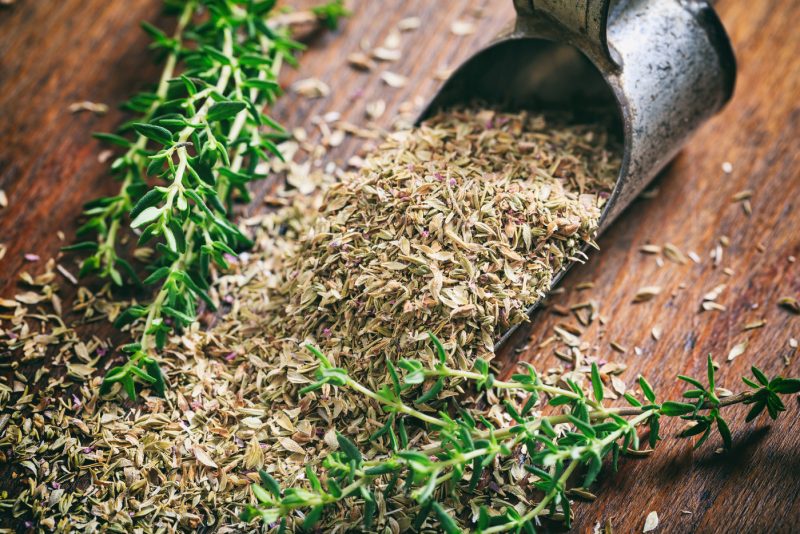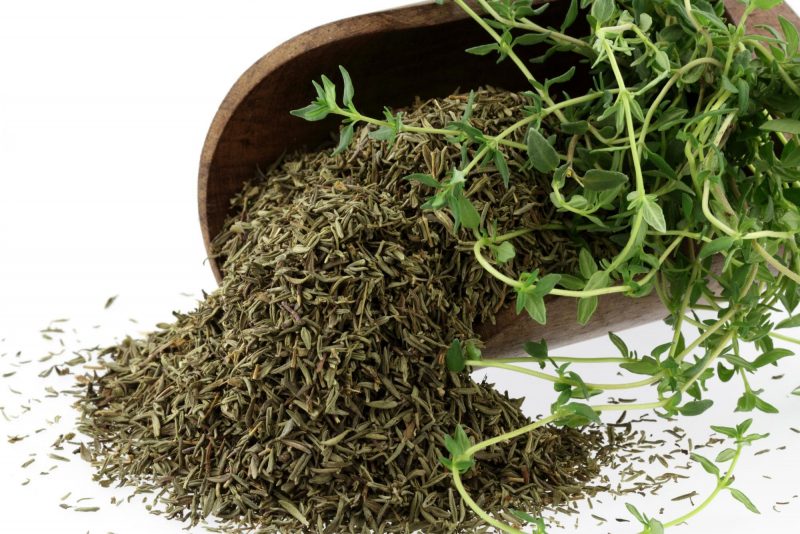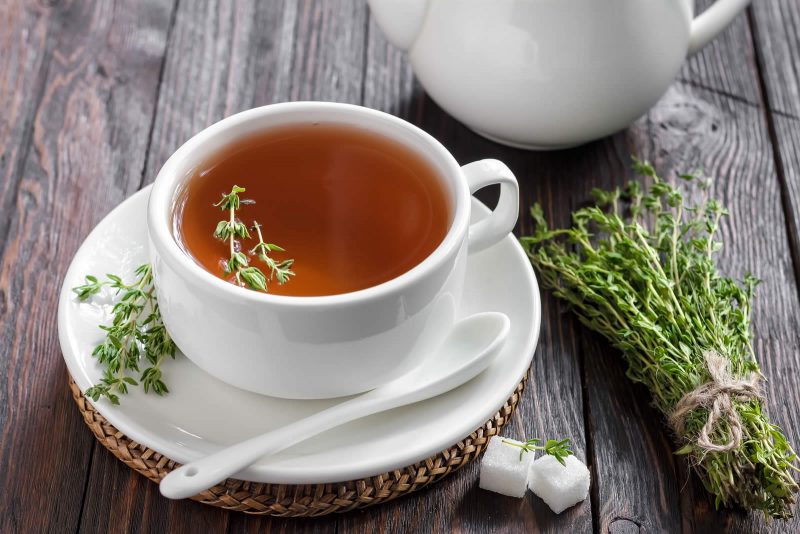To make the dishes especially aromatic and tasty, housewives often add thyme seasoning to their culinary masterpieces. What properties does this spice possess, what is it made of, how to use seasoning correctly - useful information in our article.
Material Content:
What is thyme seasoning
This spice, beloved by many, consists of leaves and inflorescences (less often) of thyme - a plant belonging to the semi-shrubs from the Labial family. It is also called spicy grass or thyme. It received its Latin name Thymus (in translation - “strength”) due to its particularly strong aroma.

The shrub has thin stems that spread along the ground, small oval leaves and lilac-purple inflorescences of small flowers. The fruits of the plant look like small black nuts.
But for seasoning, the plant must be collected before the fruits appear.
Thyme has more than four hundred varieties. The most common are creeping thyme and common thyme. It is these species that grow in our latitudes.
In Russia, grass is called in a special way - Bogorodskaya. And all because small purple flowers appear on the eve of the great feast of the Assumption of the Blessed Virgin Mary. Previously, it was they who decorated the icons of the Virgin Mary in honor of this day.
Before the advent of Christianity, thyme in Russia was considered a healing plant that can not only improve human health, but also return it from the world of the dead. It was this herb that was used for fragrant smoking in the ceremonies of our distant ancestors. And not only. The ancient Greeks and Romans thus paid tribute to their gods, adding thyme to bonfires for sacred sacrifices.In Rome, grass was used to embalm mummies, as well as an antiseptic and a means of improving the body's defenses.
Thyme's homeland, where does it grow?
Ideal conditions for the growth of fragrant shrubs created in the Mediterranean countries. It is there that they bloom in rocky soil in a dry climate.

Thyme grows well:
- in sandy soil;
- in open areas (clearings, meadows);
- in pine forests;
- in the steppe;
- in the hills;
- on the rocks.
The plant in nature is distributed throughout Europe, Asia, Africa and America (its northern part). Also, grass for industrial purposes is cultivated all over the world. In Russia, the natural areas for shrubs are the central regions and the south of the country. Harvesting grass in the Krasnodar Territory, the Caucasus, the Urals and the Stavropol Territory.
You can grow thyme at home on the balcony, the plant is completely unpretentious.
Taste and smell of thyme
The aroma of Bogorodskaya grass cannot be confused with anything. It is richly spicy, a little pungent, but pleasant. This smell gives the plant phenolic compounds in its composition.

The aroma is fully revealed during the cooking process, so thyme is almost always added at the very beginning of cooking.
On the palate, the leaves are a little bitter, with a specific camphor shade and slight pungency. They give new shades to many dishes.
The best option is to add fresh leaves or a whole branch of the plant to the food, enriching the dishes with healthy vitamins. But this can be done only in the summer, but dried as spices are used all year round.
How can I replace the spice
The spice has an original aroma; a similar spice cannot be found.

But if it so happened that during cooking it is not possible to add your favorite fragrant seasoning, then in dishes it is quite possible to replace thyme with marjoram or our motherboard (under the more fashionable name oregano).
What dishes add thyme
Different types of spicy herbs are suitable for aromatic dishes. Lemon, caraway, creeping or ordinary thyme - each has its own shades of smell and taste.

It should be borne in mind that dry spice has a richer flavor than fresh leaves and twigs.
In recipes, 1 tablespoon of ripped leaves can be replaced with 1 teaspoon of finished dried seasoning.
Regardless of what dishes the spice will be used for, it is better to put it not at the end of cooking. The fact is that heat treatment allows the aroma to fully open, emphasize the taste of the ingredients and create a real culinary masterpiece even from the simplest products.
Thyme sprigs give a unique flavor to pickles and pickles for preserving vegetables.
Where else add thyme:
- when smoking fish and meat;
- to salads;
- for insisting on vegetable oil;
- to meat dishes;
- for the preparation of pasta based on butter and finely chopped leaves;
- first courses, especially bean soups;
- in dough for bread and confectionery;
- in vegetable dishes;
- when cooking homemade cheese.
It is important not to overdo it with seasoning, so as not to make the dish too bitter - this is negatively displayed on the digestive organs.
In the food industry, spicy grass is added to sausages, canning and alcoholic beverages.
Thyme Drinks
Tea with thyme has special properties. This drink is able not only to warm on cold winter nights, but also to cheer up after a busy day, relieve fatigue and improve mood.

To make healing nectar, you can simply add a sprig of thyme while brewing regular black or green tea.
And you can use other recipes with spicy herbs.
- Insist a teaspoon of dry thyme in 50 ml of boiling water for 10 minutes. Then add another 150 ml of boiled water, wait 5 minutes and strain. The drink tones up, adds vitality.
- Mix the dry leaves of thyme, mint and oregano (5 g each), place them in a bowl, pour 300 ml of boiling water and close the lid. Wait 10 to 15 minutes, then you can drink. Tea calms, improves mood and helps to fall asleep.
- Pour spicy herbs and sage (1 teaspoon each), raspberry leaves (1 tablespoon) and currants (2 tablespoons) into a large teapot. Pour boiling water over the mixture (300 ml) and leave for 5 minutes. Add a tablespoon of black tea, a glass of boiled water and leave it under the lid for another 5 minutes. Strain, add sugar or honey to taste. Such tea can be drunk throughout the day. The drink replenishes the body with vitamins, improves mood and strengthens the immune system.
The aroma of spicy herbs is also used to make alcoholic cocktails. A sprig of thyme gives piquancy to drinks.
Health benefits of thyme
Cooking is not limited to the use of spicy herbs. The healing characteristics of this plant were mentioned in his writings by the well-known Persian doctor Avicenna.

The shrub is rich in healthy essential oils, amino acids, trace elements and vitamins. The special composition determines a wide range of medicinal properties of the plant.
Among them:
- diuretic;
- blood purifying;
- anti-inflammatory;
- antibacterial;
- sedative;
- antispasmodic;
- choleretic;
- disinfectant;
- expectorant;
- decongestant;
- anesthetic;
- anthelmintic.
The positive effect of the drugs is used by official medicine. Thyme is part of many cough medicines, such as Pertussin.
Decoctions, infusions, rubbing, rinsing and lotions according to recipes of traditional healers effectively eliminate the symptoms of various diseases:
- bronchitis, pneumonia, whooping cough;
- sciatica, osteochondrosis;
- hypotension;
- gastrointestinal pathology;
- neuralgia;
- heart dysfunction;
- problems with potency;
- diseases of the genitourinary system;
- hormonal disruptions;
- anemia, chronic fatigue;
- trouble sleeping;
- skin diseases;
- wounds, cuts, ulcers.
Thyme rightfully earned the name of healing grass. It not only gives the dishes a special aroma and adds a pleasant bitterness, but also makes them more healthy.












